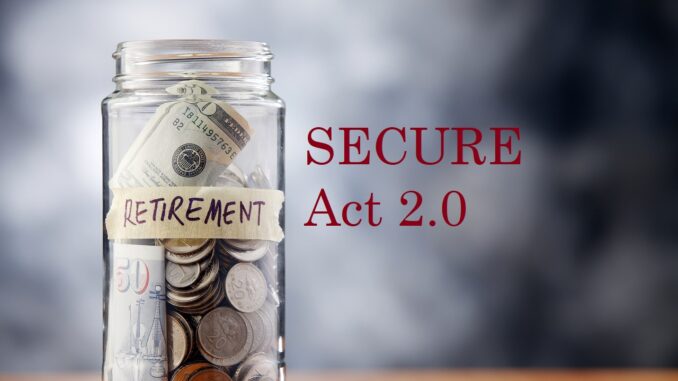
It’s questionable. Is the answer really just a matter of revising and adding more rules to the way Americans save for retirement? Can the acrobatic acronym creators save us once again with thousand-page laws that no one seems to read until after it is passed? Will more government intervention help the looming retirement crisis in America? Politicians certainly think so. However, like most acts of congress, we will have to wait and see what the real (non-political) world does versus what congress intended.
The provisions of the act go into effect over the course of the next few years, and even some of those in place for 2023 are still pending “guidance”. Here is a look at a few of the provisions, and how they may, or may not, “enhance” every community’s retirement.
Effective in 2023
Required Minimum Distributions
The Act increases the age to start taking required minimum distributions (RMDs) to 73 in 2023 and to 75 starting ten years later in 2033. This provision is not going to help younger people save more for retirement and will likely only benefit wealthier individuals who do not need income from their IRAs. Being able to keep money invested for a few extra years could allow for more growth of retirement accounts, but it could also mean higher tax payments for retirees when they do eventually need to take distributions.
The age in 2022 for taking required minimum distributions was 72, so if you are 62 years old today, ten years from now, you will get an additional 3 years before having to take RMDs. I wonder what the average age of members of congress is? Just kidding, just kidding, I am sure that has nothing to do with it.
Small Business Start-up Costs
Secure Act 2.0 increases the tax credit for employers with up to 50 employees from 50% to 100% of the administrative costs. The credit is available for 3 years and has a cap of $5,000. Small employers will need to discuss this provision with their tax advisor to calculate the exact amount of credit they can receive.
This provision incentivizes small employers to provide access to a company-sponsored plan and will help automate retirement savings, a key behavioral component to growing a nest egg.
However, there is a narrative that the reason some people do not have retirement savings is that they do not have “access” to a retirement plan. That is false. Everyone with earned income can open and contribute to an IRA account. What is true, is that not everyone works for a company with generous employer matching, and matching programs have a high impact on participation rates.
While tax incentives are helpful for companies that want to start a new retirement plan, small employers may also want to consider whether they can provide a plan that includes a matching component. Otherwise, when the tax credits run out, they may end up with an expensive retirement plan and very low employee participation.
Optional ROTH Treatment of Employer Contributions
Prior to SECURE Act 2.0, all employer contributions (i.e., matching and profit-sharing) were contributed to employees on a pre-tax basis. Participants could have their own deferrals go into a Roth 401(k) account, but all matching money would still be in a traditional bucket. One reason is that many employers choose to vest non-elective contributions and it would be unfair to impose a vesting schedule on dollars an employee already paid taxes on.
Therefore, if a vesting program for employer contributions is a priority, then this provision presents a problem because Roth-type matching money will have to be 100% vested.
Recordkeepers and payroll companies are currently awaiting guidance on how to implement the provision this year. The recordkeepers I have spoken with say it is a matter of upgrading systems to get contributions and payroll deductions coded properly.
2 Cents
The three most important words in the 401(k) world are; participants, participants, participants. Professional service providers (the good ones) focus intensely on participant outcomes. Hopefully, this new Act will achieve its intended purpose and “enhance” those outcomes.
On the other hand, in my current practice as a CERTIFIED FINANCIAL PLANNER™ practitioner, I work for many people who are enjoying financially rewarding retirements. None of them had the help of SECURE Act 2.0.
Simply put, they are people who got an education sufficient to maintain jobs with good benefits (primarily health insurance), they made staying out of debt a high priority, lived a modest lifestyle, and saved as much as possible.
People do not need 90 provisions of new retirement plan legislation to accomplish those things.
More to come on the provisions that happen in 2024 and beyond. Stay tuned.
The opinions and commentary of the author are provided for general and educational purposes only and are not intended to provide legal, tax, or investment advice.
Information is as of the date published and may not contain updates or changes to the topics covered.
This information is not intended to reflect a current or past recommendation concerning investments, investment strategies, or account types; advice of any kind; or a solicitation of an offer to buy or sell any securities or investment services.
Wyatt Moerdyk is the CCO, and managing member of Evidence Advisors, LLC, a registered investment advisory firm.

